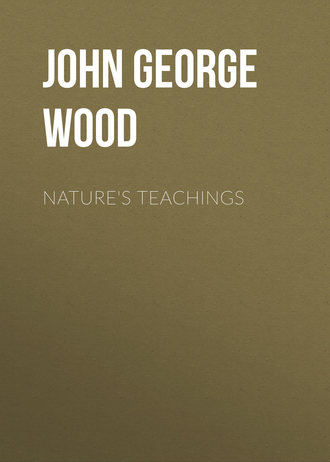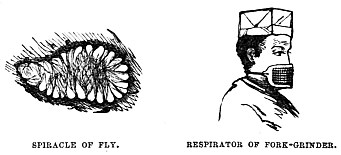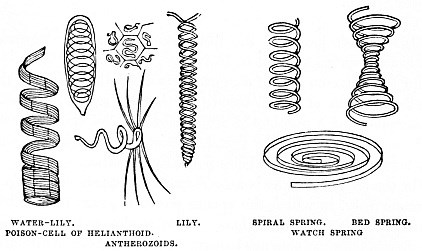 полная версия
полная версияNature's Teachings
The whole of this apparatus is abundantly supplied with nerves, and is evidently a most exquisite instrument of touch. The reader will now understand the peculiar movements of a duck’s beak while feeding. Although the bird can and does eat solid food, such as barley, and, by reason of its superior width of beak, will very much defraud the poultry in a yard where ducks and hens are kept together, it is chiefly fitted for extracting nourishment from water, and will find abundant subsistence where a hen would die of starvation.
When the beak is plunged into the water, the mandibles are rapidly opened and shut, the tongue incessantly working backwards and forwards between them. Consequently, not only are the solid parts of the water strained between the comb of the upper beak and the grooves of the lower, but they undergo a further sifting or filtering from the delicate fibrils which fringe the edge of the tongue.
Another familiar example of the Filter is to be found in the jaw of the Greenland Whale. In this animal, as well as in its congeners, the “whalebone,” or “baleen,” as it is more properly called, is so formed that it allows liquids to pass through it, while it retains solids. Feeding as it does upon small marine matters, it would starve but for the filtering power of the baleen, which enables the animal to take into its vast mouth the sea-water with its inhabitants, and to expel the water through the plates and fibres of the baleen, while retaining the animals.
The process of filtering, as well as the structure of the baleen, is so familiar that it does not need further description.
We will now proceed to another filter, which is used in the air, and not in water, namely, the Mouth-guard or Respirator of the fork-grinder.
There is, perhaps, no trade which is more destructive of human life than that of the fork-grinder was until the peculiar respirator was made obligatory. The minute particles of steel thrown off by the grindstone fill the air, and were necessarily inhaled. Now, the human lungs are capable of enduring very bad treatment, but the introduction of steel-dust into them is more than they can bear. Consequently the duration of human life was very short, consumption almost invariably setting in at an early age, and carrying off the men before they had achieved middle age.
Nor did the mischief end there. It was bad enough that life should be shortened, but far worse that it should be wasted, as was mostly the case. The men, knowing what their fate must be, were simply reckless, and plunged into all kinds of debauchery, under the plea of “a short life and a merry one.” They knew no better, and could scarcely be blamed for their mode of living. And, as a matter of course, each succeeding generation was worse, smaller, and feebler than the preceding.
Then there came the invention of the Magnetic Respirator, by which the fork-grinder’s trade was rendered as healthy as any other. It was made of steel-wire gauze, and magnetised, so that the floating particles of steel were not only stopped in their progress to the lungs, but arrested by the magnetism, and, so to speak, taken prisoners by it.
Even a well-made respirator of several layers, like those which are used by persons suffering from weak lungs, would have been useful, but the addition of magnetism doubled the efficacy while greatly diminishing the cost, a single layer of wire being quite adequate to the office, and was, in fact, quite a stroke of genius.
The value of this invention is at once shown by the many complaints which the workmen made when the Respirator was first introduced. They complained that the apertures of the Respirator became so choked that they could not breathe. This was perfectly true, but the complaint showed the real value of the instrument.

It was necessary for the workmen, every now and then, to clear off the innumerable particles of steel which adhered to the magnetised wires, and impeded respiration. But they never seemed to realise the fact that, if it had not been for these wires, all the particles would have been drawn into the lungs, and gradually choked them up, brought on inflammation, and extinguished their life altogether. And, with the usual repugnance to new ideas which is inherent in undeveloped minds, the men stoutly resisted the introduction of the Respirator, and did their best to reject an invention which doubled the length of their lives, and enabled them to find long happiness in the world instead of brief pleasure ended by sure and painful death.
Now, we will see how the principle of the Respirator is carried out in Nature.
On the left hand of the illustration is drawn one of the most perfect Respirators, or air-filters, if we may use the term, that can be imagined. Perhaps some of my readers may know that insects do not breathe as we do. They have no lungs, but their entire system is permeated by air-vessels, just as is our system with blood-vessels, and therefore the air, instead of being restricted to the lungs, is conveyed to every part of the insect, the air-vessels extending to the very tips of the wings and antennæ, and to the claws of the feet.
Neither does the insect receive the air through mouth or nostrils as we do. Along the sides of the body are certain oval apertures called “spiracles,” from the Latin word spiro, which signifies breathing. These spiracles can easily be seen by examining an ordinary silkworm. They are situated in the soft and flexible skin which connects the rings or segments of which all insects are composed, and pass directly into two large air-tubes which run on either side of the body.
It is evident that since an insect is so thoroughly permeated with air, it must be furnished with means to render that air as pure as possible, and at all events to preserve the respiratory system from being choked with dust or other adventitious substances.
How important the air is to an insect can easily be seen by dipping it in oil, or even brushing an oiled feather on its sides so as to fill up the spiracles. A man under the hands of the hangman or garotter could not die more swiftly, so much does an insect depend on air. In fact, an insect is almost wholly composed of air-tubes, but for which the great thick-bodied dor-beetles could never use their organs of flight.
Of course, although the spiracles can act as filters as far as the air is concerned, they cannot be analysts, and consequently insects are peculiarly sensitive to a bad atmosphere. There is, for example, the well-known “laurel-bottle” of entomologists. A few young laurel-leaves are crushed and placed in a bottle. As soon as an insect is introduced, it breathes the prussic acid which is exhaled from the leaves, and at once dies.
So it is with the more delicate “death-bottle,” into which a little cyanide of potassium is introduced, and covered with plaster of Paris. The plaster prevents the poison from touching the insects and damaging their beautiful colours. It permits the deadly vapour to roll through its interstices; consequently, even the large-bodied moths, which are tenacious of life almost beyond credibility, can barely run round the bottle, when they roll over, and expire almost without a struggle, the venomous atmosphere having saturated the entire body.
All entomologists know that the spiracles act as sieves, preventing any extraneous objects from gaining admission into the breathing-tubes. But, unless they have had personal experience, they cannot appreciate the efficacy of the spiracle when acting as a respirator. Even the microscope, though it may magnify the object to any extent, does not show the wonderful filtering power of the spiracle. The figure in the illustration represents a spiracle of the common “blue-bottle” fly, and any one who wishes to examine such an object for himself can have but little difficulty in doing so, especially in the warm season of the year.
How effectual is the barrier thus interposed by Nature between the external world and the interior of the insect may be inferred from the following narrative:—
Many years ago, while absorbed in the comparative anatomy of insect structure, I believed myself to have hit upon a plan for injecting the minutest of tubes with mercury. So I took a male cockroach, placed a vessel of mercury in the receiver of an air-pump, and suspended the cockroach exactly over it. As the reader will fully have surmised, my idea was, first to exhaust the air from the inside of the insect, then to plunge it into the mercury, and then to admit the air, which, at a pressure of fifteen pounds to the square inch, was likely to drive the mercury into the smallest of tubes. Such a plan was very successful with ordinary tissues, and might succeed with insects.
Accordingly, I exhausted the air from the vessel in which the cockroach was placed, and kept it in a state of exhaustion for a whole day, so as to prove that every particle of air was withdrawn from the insect. I then plunged the cockroach deeply beneath the mercury, and admitted the air, hoping that the severe pressure would drive the mercury into the respiratory vessels. But not one particle of the mercury could pass through the wonderful filter with which the cockroach had been provided, and, except that I had learned the power of the spiracle, I might have saved both the time and trouble.
It is worthy of notice that, almost countless as are the species of insects, no two of them possess exactly the same structure of the spiracles, the individuality being marked as clearly in these tiny organs as in the entire insect.
CHAPTER V.
THE PRINCIPLE OF THE SPRING.—THE ELASTIC SPRING.—ACCUMULATORS.—THE SPIRAL SPRING
Springs and their various Structure.—The Elastic Spring.—The Boy’s Catapult and its Powers.—The Pistolograph, its Principle, and Uses to which it can be put.—Leaf-rolling Caterpillars, and their Way of Work.—The Carriage Spring.—The Horse’s Hoof and its complex Structure.—Fungi and their united Power.—The Chinese Cross-bow.—The ancient Balista.—Skull of the Crocodile.—Bones of young Children.—The Spiral Spring and its many Uses.—The Toy-gun.—The Needle-gun.—Valved Brass Instruments.—Watch and Clock Springs.—The Bed Spring.—Parallels in Nature and Art.—Buffers of Railway Carriages.—Spring Solitaires.—The Bell Spring.—Spiral Springs in Vegetable Tissues.—Poison Cells of various Marine Animals.—Effects of the Spiral Springs.
Elastic SpringsHERE we come upon a subject so large, that it is difficult to define its exact requisite limits. The principle of the elastic spring pervades all Nature, and the numerous adaptations in Art are closely, though perhaps not directly, attributable to the wide distribution of the spring in Nature.
There is, for example, the simple elasticity which enables a tree, when bowed by the wind, to spring back so soon as the pressure is removed, and which, indeed, is the power which enables a bow to propel an arrow. Then there are spiral springs innumerable, many of them so minute that they can only be seen by the aid of the microscope, and there are many springs which exhibit their elasticity by their power of extension and shortening, just as is done with the elastic fabrics which are so much in vogue at the present day, and which seem so necessary to ordinary comfort that we feel disposed to wonder how our forefathers managed without them.
We will now proceed to examine some of these springs in detail.
There is one form of elastic spring which has of late years become more familiar than agreeable, namely, the toy which is learnedly called a “catapult,” though it has little in common with the ancient weapon whose name it bears.
As may be seen by reference to the illustration, it consists of one or more india-rubber straps attached to a fork-like handle, and carrying a small pouch in which is contained the missile. Although it is not remarkable for accuracy, it can throw a stone or a bullet a considerable distance, and its power can be very quickly increased by adding to the number of the straps. Thus a catapult has been made which was capable of sending a small pistol bullet through a wooden board, so that the child’s toy might really become a dangerous weapon.
Indeed, cases are known where the catapult has hurled a stone with fatal effect upon human beings. In my own neighbourhood there are many examples of glass being pierced by stones thrown from catapults just as if they had been subjected to bullets shot from firearms, the holes being quite small and round.
The power of accumulating force by increasing the number of springs was utilised by Mr. Scaife, when he invented his wonderful photographic machine which he termed the “Pistolograph,” on account of the sound which was produced when the portrait was taken.
The idea was simple enough, though the practice of it was not so easy. He wished to be able to take a photograph with an exposure of the least possible time, and thus to attain freedom and action, instead of the dull stiffness which generally characterizes photograph portraits. The mode which he adopted was by introducing a peculiarly sensitive film, which would take an impression in a mere moment, and then arranging the machine so that an exposure of more than a moment was impossible.
This was done by covering the lens with an exactly fitting door, revolving on a pivot. The axis on which the door revolved was attached to a number of india-rubber bands, exactly like those which are used for confining papers. As the power of the springs increased with their number, it naturally followed that the rapidity of the revolution was in exact ratio with the number of the bands, so that the duration of exposure to light could be measured with tolerable accuracy.
So wonderfully well did this plan succeed that photographs of eclipses were taken with perfect accuracy, a matter of great importance when time has to be considered. Horses were also taken at full gallop, so as to display their action, and the crowning achievement was the photographing of a cannon in the act of firing, and the bursting of a charged shell. So rapid is the action of the instrument, that in several cases where a cannon or mortar had been photographed, even the track of the ball or shell is visible.

It necessarily followed that when the springs caused the circular cover to revolve with such rapidity, they made it close with a sharp report, and so gave rise to the name of the machine. Moreover, as it had to be used for rapidly moving objects, it was not fixed on a pedestal, but was held in the hands, while aim was taken at the object, just as with a pistol. When the observer thought that he had his aim correct, he touched a trigger, round spun the cover, and the photograph was taken.
On the right hand of the illustration is seen the Catapult, made with several springs, and on the left is shown an example of the Accumulator as formed by Nature.
The reader may probably be acquainted with the Leaf-rolling Caterpillars, of which there are so many. I had often inspected these curled leaves, and, on comparing them with the size of the caterpillars, had noticed that the muscular strength of the insect was quite inadequate to the work which was done. That much of it was owing to the “bowsing” system, which has already been described when treating of the Toggle-joint, was very probable, but that some other force must be employed was evident.
On unrolling a leaf, the hidden force was at once explained, and showed itself to be a system of accumulators exactly like those of the pistolograph or the catapult. The caterpillar spins successive belts of silken threads, and affixes them to the leaf, as shown in the illustration. These threads are nearly as elastic as the india-rubber bands of the catapult, and accordingly draw the leaf together. Another set of belts is added above the former, and, as they harden and contract in the air, they roll the leaf still further. The first row is then shortened and tightened, and a third and fourth row are added in the same fashion. So elastic are these belts, that if the leaf be carefully handled it can be almost wholly unrolled, and will spring back again as soon as the force is removed.
Another form of accumulated force may be seen in the ordinary Carriage Spring, one of which is shown in the illustration. It is made of a number of strips of elastic steel lying upon each other, and suffered to play upon each other by means of slots and rivets. The weight being placed in the centre, it is evident that this very ingenious spring is really an elastic girder, yielding to sudden pressure, and recovering itself when that pressure is removed.
Ingenious as is this spring, it has many parallels in Nature, one of which is here given.
It is popularly thought the hoof of the horse is a solid mass of horn destined to protect the feet against hard and rough ground. Such certainly seems to be the opinion of farriers, who, in shoeing horses, act exactly as if the horn of the hoof were structureless; whereas it is a marvel of complicated mechanism. On looking at the exterior of a horse’s hoof, it will be seen to be marked with a vast number of very fine, but easily visible longitudinal lines, looking as if they were scratches from a very fine needle. If the hoof be removed from the foot, and examined upon the interior, it will be seen that each of the apparent scratches signifies the edge of a very thin plate of horn, not so thick as the paper on which this book is printed. The hoof, in fact, is built up of multitudinous plates of horn, set side by side, and each acting as a separate spring. It is this beautiful structure which allows the horse to tread without a jar being sent through its whole system by every step which it takes.
A similar structure is to be found in all hoofed quadrupeds, and is especially noticeable in the case of the Elephant. All those who have watched the walk of an Elephant, no matter what its size may be, must have been struck with the curious noiselessness of its movements. Its weight may be measured by tons, and yet the enormous animal steps as noiselessly as a cat. On examining one of the hoofs, after it is removed from the foot, the cause of this marvellously silent tread is perfectly evident. The whole of the hoof is composed of nearly parallel horny plates, and by their united action they produce the required result.

Each plate in itself is very feeble, but, when united as they are at the ends, they afford mutual support to each other. Similarly the separate feathers in a couch would be crushed by a comparatively slight weight, but when a number are confined together they support each other, and form the soft, yielding couch with which we are so familiar. Horsehair, when used as the stuffing for a couch or chair, acts in the same way, and so do the fine filaments of wool when used under the name of “flock.”
Another good example of the power of accumulated force, although it has no direct relation to the spring, is the well-known fact that fungi, which are separately so fragile, are capable of lifting and retaining in the air stones so large that two men could hardly carry them. Were the stones laid down upon the fungi, the latter would be crushed, but, as they grow beneath the stones, they accumulate their powers, and slowly, but certainly, raise the weight from the ground.
This very principle of accumulated force has long been used in weapons of war, and I possess several examples of such weapons. One of them is a Chinese repeating Cross-bow, which was taken at the capture of the Peiho Fort, and was really a formidable wall-instrument, carrying a reserve of arrows, and delivering them with great rapidity. In point of fact, it consists of three bows, placed upon each other, and playing upon each other just as do the portions of a carriage spring. Such strength is thus obtained, that the bow cannot be drawn by hand, but is worked with a lever, as shown in the illustration. The whole machinery of the weapon, including the self-notching and self-supplying system, is very interesting, but is outside our present object. The very powerful bow of the ancient Balista was made on the same principle, and was strong enough to throw large stones and wooden beams.

I also have bows in my collection which are strengthened on the same principle, though not exactly in the same manner. There are several Indian, Chinese, and Japanese bows which are curved almost like the letter C, and have to be reversed when strung. These bows are of no very great size, but possess wonderful elasticity. They owe the latter quality to sundry layers of sinew which have been affixed to the back when wet, and which add enormously to the power of the bow, while they very little enlarge its dimensions.
Another bow, made by the natives of Vancouver’s Island, has the back strengthened by a number of cords spun from sinew fibres, and possessing the strength and elasticity to which we are accustomed in the strings of the harp, guitar, or violin.
We will now turn to a parallel in Nature. This is to be found in the lower jaw of the Crocodile, as is pointed out by Professor Owen, in his work on the “Skeleton and the Teeth.”
All persons who have a smattering of anatomy are aware that even in the human body the most solid bones of the adult were originally composed of several pieces, and that they only become fused together in course of time. The jaw-bones, for example, were once so composed, and in the Crocodile the junction is never completed, the pieces of bone remaining separate, but being pressed firmly against each other during life.
I have now before me the skull of a Gangetic Crocodile, in which, although the animal was an adult when killed, the bones of the long lower jaw are so loose that unless they were tied together the jaw would fall to pieces.
This analogy between Art and Nature is thus described by Professor Owen in the work which has just been mentioned:—
“The purpose of this subdivision of the lower jaw-bone has been well explained by Conybeare and Buckland, by the analogy of its structure to that adopted in binding together several parallel plates of elastic wood or steel to make a crossbow, and also in setting together thin plates of steel in the carriage spring.”
Dr. Buckland also adds: “Those who have witnessed the shock given to the head of a Crocodile by the act of snapping together its thin, long jaws, must have seen how liable to fracture the lower jaw would be were it composed of one bone only.... The splicing and bracing together of thin flat bones of unequal length and of varying thickness afford compensation for the weakness and risk of fracture that would otherwise have attended the elongation of the parts.”
A good example of the value of this structure of bone may be found in young children. Before they are old enough to take care of themselves they are perpetually falling down, and never hurting themselves. I have seen a little girl of five years old roll from top to bottom of a lofty staircase. It looked as if the child must be killed, but she was only giddy with her many revolutions, and a little bruised about the elbows. The reason of this curious immunity from injury is, that the bones, especially those of the skull, are not completely united, and so act on the principle of the compound spring.
The Spiral SpringThis subject is so large, and there are so many examples, both in Art and Nature, that it is not very easy to make selections which will sufficiently answer the purpose.

The upper left-hand figure of the illustration represents the ordinary Spiral Spring made of wire, and used for its power of resuming its shape when compressed. In early childhood most boys have had practical experience of this spring in the toy guns and cannons with which they are supplied. The spring is compressed by the ramrod, and held in its place by a catch. If a pellet be placed in the gun, and the catch released by pulling the trigger, the spring flies back to its former shape, and drives the pellet.






